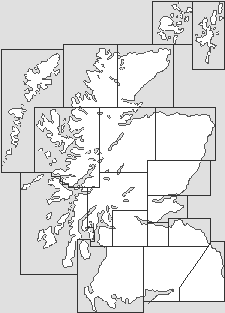 Glen Shiel, the Layby and Area of the Battle |
Anyone with any interest in history will have heard of the Jacobite uprisings of 1689, 1715 and 1745. Fewer will be aware that a French fleet almost succeeded in landing troops in the Firth of Forth in 1708 in pursuit of the Jacobite cause, or that another planned French invasion in 1744 was only abandoned after their fleet was scattered by one of the worst storms of the century.
Then there was the brief and ill-fated 1719 uprising, "the Nineteen", which reached its conclusion at the Battle of Glen Shiel on 10 June 1719. The background to the uprising was Spain's decision to support the Jacobites claim to the British crown, and to that end she launched a fleet large enough to land a force of 7,000 troops in southern England. In an echo of the fate of the Spanish Armada in 1588, and like the later French fleet in 1744, the 1719 Spanish fleet ran into a storm on 29 March and turned back.
The plan was for the main attack to be preceded by a diversionary landing in north-west Scotland, which it was hoped would raise the Jacobite clans and draw Government forces away from the intended location of the main landings. In an era of limited communications the diversionary landing took place, with those participating unaware that the main fleet had turned back and they were on their own. (Continues below image...)
 Looking Down the Glen from the Information Panels |
On 13 April 1719, William Murray, Earl of Tullibardine, and George Keith, the Earl Marischal of Scotland, landed with a force of 300 Spanish marines in Lochalsh, and sent out messengers to call the clans to arms. The debacle of the failed 1715 uprising was still fresh in many memories, however, and only around 1,000 clansmen answered the call. The Jacobites took control of Eilean Donan Castle as their headquarters, and it was garrisoned by 46 Spanish marines.
On 10 May 1719 three Royal Navy frigates sailed into Loch Alsh and Loch Duich and bombarded Eilean Donan Castle. The garrison surrendered and the Navy proceeded to blow up what remained of the castle to prevent it being used again: along with 343 barrels of Spanish gunpowder that had been stored there.
The remaining Jacobites, comprising some 200 Spanish marines and 1,000 clansmen, decided to march on Inverness, but encountered a force of Government troops making its way towards Lochalsh from Inverness. The two forces met in Glen Shiel on 10 June 1719.
The Government commander, General Joseph Wightman, had around 850 infantry, 120 dragoons and 4 mortar batteries at his disposal. As well as being at a numerical disadvantage he found that the Jacobites had occupied the high ground rising on either side at a point where Glen Shiel narrows markedly. On paper, the Jacobites had a significant advantage.
Fighting began in the early evening, and the Jacobites' numerical and positional advantages were thrown away through poor leadership. By 9pm the Government troops had overrun the Jacobite positions. Many of the Spanish marines had no choice but to surrender, while the surviving clansmen melted away into the surrounding landscape. The Government side suffered 21 dead and 121 wounded in the battle, while the Jacobite forces suffered at least 100 fatalities. In all, 274 Spanish marines were taken prisoner and were returned to Spain in October of that year.
Today the site of the battle is marked by information panels set into a stone wall in the foot of the glen, and by a nearby cairn and a brown tourist sign. The role of the Spanish marines in the battle is remembered in the name given to the mountain on whose flanks they fought on the north side of the glen, Sgurr nan Spainteach, or "Peak of the Spaniards".
 Steep Northern Side of the Glen |

|
|
|
Visitor InformationView Location on MapGrid Ref: NG 994 134 What3Words Location: ///flanked.hillsides.panic |
 Looking Up the Glen |
 Cairn |
 Stream on North Side of Glen |
 Eilean Donan Castle |



